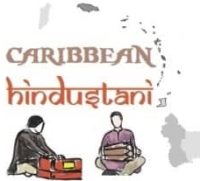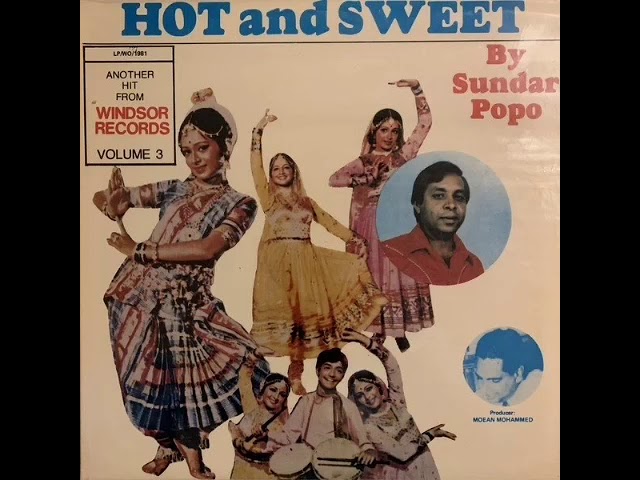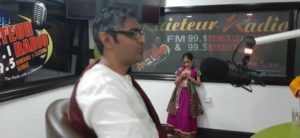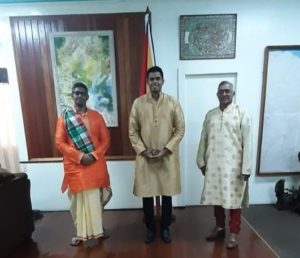147th Ápravási Divas
(Hindustan Immigration Day)
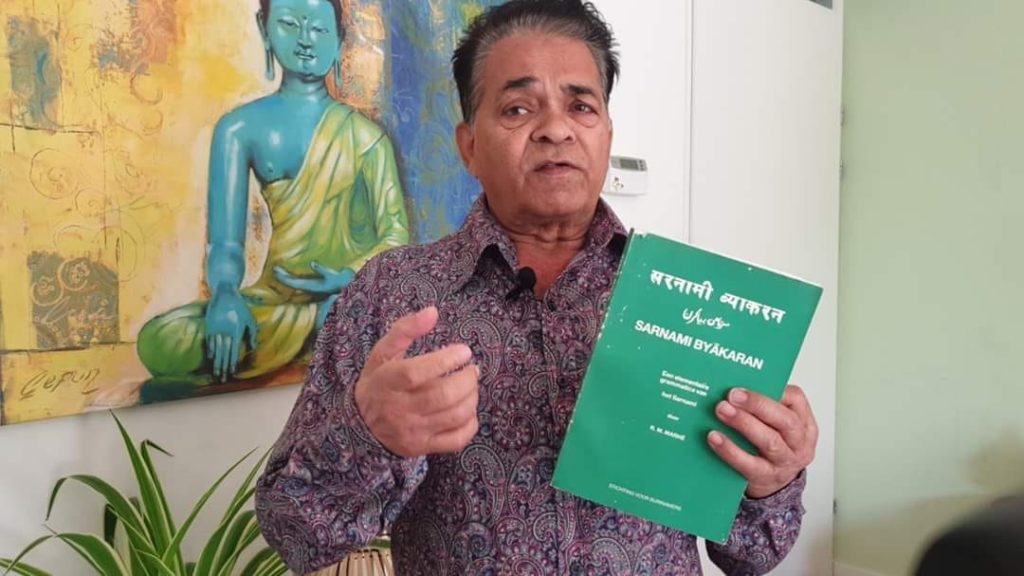
Marhe is a key resource person from the Netherlands’ Dutch Surinamese Hindustani diaspora. His book “Sarnámí Byákaran” (Sarnami Grammar) is a key reference text for Caribbean Hindustani’s language initiative on the heritage and ancestral speech of the descendents of Indian indentured labourers in the Caribbean. Here is his message on Suriname’s Indian Arrival day to be celebrated on June 5th, 2020:
Sarnami, legacy of Baba and Mai, ham log ose ká karila
By: Drs. R.M. Marhé
On June 5, 2020, we commemorate the 147th Ápravási Divas (Hindustan Immigration Day) in both the Netherlands and Suriname. In this article I want to talk about the Sarnami as an inheritance from Baba and Mai and how young intellectuals in the Netherlands and later in Suriname from 1971 onwards cherish it and want to protect it from a fameless destruction. For this, it is important to highlight the origins and development of the Sarnami Emancipation Movement in the Netherlands and the role of key players in it and some of their successes and setbacks.
Aur ab Sarnami men: Sarnami Ándolan ke suruvát, vikás aur phal.
Background Suriname From 1960 to 1969 I took Hindi lessons at Babu Mahatamsingh in Paramaribo. He was the cultural attaché of India. I made good progress and from 1962 onwards I taught Hindi lessons at private schools (pathshalas) in the form of seva, selfless service. I want to get rid of a persistent misunderstanding: The Sarnami Emancipation Movement did not originate in Suriname, but in the Netherlands. The name Sarnami was coined by Dr. Jan Hansraj Adhin who wrote his Romanized Spelling of Sarnami in 1963. Adhin has found the rough diamond Sarnami, but we have cut it in the Netherlands into a sparkling jewel. On the other hand, Adhin as a loner fervently fought another important battle. against the emerging Creole nationalist dominance led by Mr. Eddy Bruma and his Wi Eygi Sani. A dominance that still exists in Suriname.
I was a student of Adhin at the nursery school. Philosophically and spiritually he strongly influenced me. In public life he was a Hindiman par excellence. He promoted Hindi, not his native Sarnami, and refused to speak from Sarnami venues. At the time, this attitude was self-evident among intellectuals, for there was no proud Sarnami consciousness at the time. Only later when the Sarnami successes from the Netherlands spread to Suriname did he start writing articles in Bhasa.
I remember e.g. how I tested his resistance later in the 90s when, on my initiative for OHM TV, I had to make a film portrait of him with the producer Sunil Ramjanam in Suriname: He wanted to be interviewed in Dutch and Hindi. But I insisted: Mr. Adhin, I want to interview you in the language you speak to your mother. I knew that his mother was not educated and therefore only had to master Sarnami-Hindustani. He had nowhere to go and the documentary was a success. Adhin’s merit is also that he convinced the Surinamese government to get a standard Roman spelling of the Sarnami recognized in 1986.
In Suriname I was sweetly disappointed in the little success of Hindi education and I did not understand the relationship between Hindi and Sarnami at that time. By the year 1967, we students from the nursery school and the AMS often came together and founded the student association Nauyuga. In particular, it was my person, Ramon Sahtoe, Chander Mathura, Gerold Jiawan, Jit Narain, Bris Mahabir, Naushad Buddha, and Suresh Chotoe who wanted to focus on cultural preservation and the development of our society. We did not yet have any explicit ideals. Because of my knowledge of Hindi, I was asked to come up with a name for our association. I then chose the name Nauyuga, which means The New Age, because we were bursting with energy and sensed that something new was about to happen. Nauyuga has been around in Suriname for more than 50 years and has proven to be an important breeding ground for young intellectuals.
Scientific basis in the Netherlands In 1969 I came to Leiden to study Dutch language and literature at the university. Most Surinamese boys and girls studied medicine, law, political science or something else. I was the only one who studied Dutch, with Hindi as a secondary subject with Dr. Shocker. In 1970, while studying, I came across an interesting article by the American linguist Ferguson, called Diglossia, which was an eye opener for me. It was then that it became clear to me what the real relationship was between Hindi and Sarnami. Diglossie means that in one community two or more variant forms of a language occur with a large difference in appreciation. In our case, Hindi has the highest appreciation, while it is not the native language of Hindostanen. On the other hand, Sarnami exists as a living and functional mother tongue, but enjoys little or no (prestige) among its speakers. It is seen as aili-gaili, tutal bhásá (broken language) and the speakers don’t think it is worth passing it on to the next generation.
At the same time, I learned in psycho-linguistics that all 6,000 languages in the world are equal; no language is higher than the other; all languages are beautiful and have a unique grammatical structure; all languages are the product of the intelligent and creative human mind. I also learned that language is an important identity element for a person who connects him to his group. Native language loss leads to cultural loss, lack of understanding, false shame, a negative self-concept, uprooting, feelings of inferiority and linguistic insecurity. Moreover, in your native language you are most confident and spontaneous when expressing your (emotional) feelings. This knowledge was a revolutionary revelation to me!
I decided to spread these thoughts for the rest of my life to make Hindostanen aware and proud of their beautiful native language. A people’s mother tongue is a wonderful way to be creative through the making of songs, Baithak Gana, poems, drama, short stories, and novels. June 13, 1971, the birth of the Sarnami Emancipation Movement I started talking about this discovery in my circle of friends, first with Suresh Chotoe, then with Jit Narain, Naushad Buddha, Bris Mahabir, and some others. On June 13, 1973, I gave a lecture about the Surname in the living room of Jit Narain at the Muiderkring in Leiden. The ideas caught on and people became enthusiastic. We can consider that date as the birthday of the Sarnami Emancipation Movement. Jit Narain started writing poems in Sarnami, Gharietje Choenni and Chitra Gayadin followed and we often performed on occasions in The Hague and other cities. In the then media we published poems and contemplative articles.
The group gradually expanded and new members came: Dew Baboeram, Krishna Autar, Ruben Gowricharn, Krish Bajnath, Alma Mahawatkhan, Sonny Badal, Raj Ramdas, Lal Goerdayal, Sitla Bonoo, Kumar Gayadin and many others. We met at the meeting center Mathura in The Hague. We were bothered e.g. to note that in Suriname during the history lessons little attention was paid to Hindustani Immigration History. The Hague Foundation for Surinamese instructed Sonny Badal, Benny Mitrasingh, and me to start looking for Hindustan heroes in the Colonial Reports, because until then Baron, Boni, and Joli Coeur were seen as the only Surinamese resistance heroes. We did indeed find those heroes in Mathura, Jumpa Rajguru, Ramjanee and Tetary. We decided to give the name Sarnami Collective Jumpa Rajguru to our action group. Mitrasingh and I wrote a brochure under that name in 1978 and I dedicated it to Baba and Mai. I came up with this name when I personally experienced discrimination at the A.T.Calorschool in 1956 against a number of our Creole classmates who called Hindu fellow students derogatory Babun and Mai. I made nicknames from these derogatory names! So this monument is not, as is often assumed, a memorial monument, but a resistance monument against discrimination, disadvantage and exploitation.
On the basis of this brochure, three monuments were erected in Suriname in 1994 and after: Van Baba and Mai in Paramaribo, van de Gevallen Helden in Mariënburg and van Tetary in Paramaribo. Now there is also a replica of Baba and Mai in Kolkata on the Hoogly River in India, which has been realized by the Indian government. Rabin Baldewsingh realized a native language monument in 2019 in the Zuiderpark on the occasion of February 21, International Mother Language Day in collaboration with Bangla Desh.
Internal Struggles Initially, in 1976, we called our group the Sarnami Collective Jumpa Rajguru and focused our attention on Sarnami language, literature and culture, history, women’s empowerment, Baithak Gana and other social issues. Later when the group’s emphasis on left-wing politics came to prevail, the name Sarnami was deleted. Pressure was put on group members to embrace socialism and renounce religion and spirituality. I was the only one who had a very principled position. After Adhin’s wise lessons in Suriname, in the Netherlands in 1977 I was very impressed by the British esotericist Benjamin Creme, who talked about the upcoming world teacher Maitreya and his Masters of Wisdom and how we destroy our planet. Esotericism and Theosophy became my second nature to which I have remained true until now. I said to the group members, “I am very much in favor of social justice, but I do not give up my spiritual spirit, because I do not believe in revolutionary violence, but in evolution, karma, reincarnation and ahimsa. I don’t feel like calling myself a communist, trotskyist, anarchist, socialist or Marxist and waging class struggles. ”
I was not thanked for that position and I decided to leave the group and continue on my own. Other group members did the same. In the late 80’s I wrote the Hindustani First Name Book, with 3000 first names with meanings, because I found that a first name for babies from their own culture strengthens their identity, instead of foreign names like Anushka, Precious, Alicia, Carla, Robby , Ivan or Carlo. We have beautiful and meaningful Sanskrit, Arabic and Bhojpuri names; why should we deny it?
People who took their inspiration from their time in Jumpa Rajguru have made important contributions to the Surinamese community. Dew Baboeram (Sandew Hira) delved into Hindustani Immigration history and together with Maurits Hassankhan he created the extensive Immigration database that provides Hindustani people with information about their roots and ancestors in India. Prof. Ruben Gowricharn proved in a scientific article that the Creole dominance does indeed proliferate in Suriname and that all Surinamese must remain vigilant so as not to be overruled. The socialist influences in Collective Jumpa Rajguru later died silently with the fall of communism worldwide.
The period Aisa Samachar In 1978 I became an information officer at the Surinamese Foundation in The Hague, publishing the monthly welfare magazine Aisa Samachar in my duties. I then had ample opportunity to propagate Sarnami and also offered my former friends an opportunity to express themselves in their controversy about revolution and social upheavals. At the time, many of my Jumpa Rajguru members published articles, poems and other submissions about the Sarnami.
I published the manifesto of the Sarnami Emancipation Movement under the name of: Why the Sarnami Emancipation? (Can be found on the internet). This article is still used in Suriname at the Institute for Teacher Training (IOL). I also had the opportunity to include hundreds of Surinamese addresses in our database, so that our homeland could also learn about the emancipatory achievements around Sarnami in the Netherlands. And that also caught on there. Jan Soebhag, Effendi Ketwaroe, Nabibaks, Uday Jarbandhan, and others gathered around Bhasa magazine. Jan Adhin, my esteemed teacher, also took part in writing articles about Sarnami.
Interest in the Sarnami was gaining ground. Jit Narain, Chitra Gayadin, Gharietje, Choenni published collections of poems in Sarnami. I traveled to India in 1976 to do scientific language research in the Bhojpuri and Avadhi area on the origins of Sarnami in Uttar Pradesh and later wrote the first grammar of Sarnami in 1985.
Further scientific interest The scientific interest in Sarnami also increased. Jit Narain convinced Dr. Theo Damsteegt to teach Sarnami in addition to Hindi at the University of Utrecht and together they wrote Ká Hál, a textbook Sarnami. Dr. Geert Koefoed has translated many of Jit’s poems into Dutch. Also important for the study of the Sarnami contributions of Prof. dr. Dr. Michiel van Kempen, Dr. Tim van den Avoird, Dr. Jha from Norway (Hindi) and Dr. Kofi Japko from the University of Hong Kong for his international research into the spread and adaptations of the Bhojpuri / Avadhi in many diaspora countries.
More media attention for the Sarnami An important breakthrough came when OHM TV was allowed to bring Hindustani programs on the Dutch television in the 90s. Rabin Baldewsingh and I were Sarnami conscious program makers and we made sure Sarnami got a place in the programs. I did my interviews with Hindostanen preferably in Sarnami and I was allowed to do the subtitles. To date, I have been affiliated with many Dutch media as subtitles. Radio and television brought us many international contacts and during my travels through many diaspora countries, I often gave lectures and presentations about our mother tongue. Almost silently, many radio and television program makers in Suriname and the Netherlands have started to use Sarnami in their programs with pride, spontaneously and with ease, in addition to Hindi. Today, Sarnami has become a universal concept and contacts have been established with other diaspora countries such as Trinidad, Mauritius, South Africa (Durban), Fiji, Guyana and the Bhojpuri region of origin in UP in India. My Sarnami grammar was recently translated into English by Dr. Visham Bhimull and Mr. Rajsingh Ramanjulu from Trinidad and will be spread across all diaspora countries.
The current state of affairs The Sarnami torch is currently mainly in the hands of the highly deserving Rabin Baldewsingh who propagates the Sarnami in the Netherlands and Suriname with unremitting enthusiasm through seminars, congresses, courses, publications, books, presentations, film material, songs, poems and more. He knows how to inspire many to participate, but we are not there yet. Sarnami is still in great danger. Hindustani youth in the Netherlands hardly speak Sarnami anymore and in Suriname this trend has already started in and around Paramaribo. I am convinced that in Suriname only politics and government can bring salvation, such as in Mauritius and Fiji. Baba and Mai do not deserve on June 5 that we only wear them with mala, but that we protect, cherish, keep alive and continue their legacy. The Surinamese constitution guarantees that there should not be discrimination based on language in that country. Let us go for that!
Jai Sarnami!
Moti Marhé (May 29, 2020)
